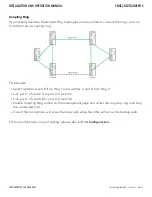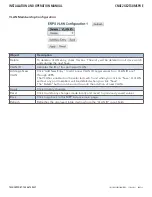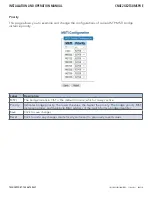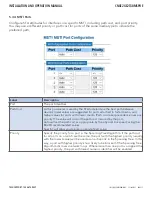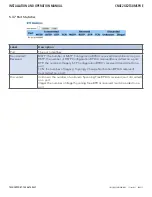
INS_CNXE2GE2TX8MSPOE 11 Jan 2021 PAGE 31
INSTALLATION AND OPERATION MANUAL
CNXE2GE2TX8MSPOE
TECH SUPPORT: 1.888.678.9427
5.3.3 CIST
CIST is used by MSTP to communicate with other MSTP regions and with any RSTP and STP
single-instance spanning trees in the network. Any boundary port connected to another region
will automatically belong solely to CIST, even if it is assigned to an MSTI. All VLANs that are not
members of particular MSTIs are members of the CIST.
Port Settings
Label
Description
Port
The switch port number to which the following settings will be applied.
STP Enabled
Check to enable STP for the port
Path Cost
Configures the path cost incurred by the port.
Auto will set the path cost according to the physical link speed by using the
802.1D-recommended values.
Specific allows you to enter a user-defined value.
The path cost is used when establishing an active topology for the network. Lower path
cost ports are chosen as forwarding ports in favor of higher path cost ports. The range
of valid values is 1 to 200000000.
Priority
Configures the priority for ports having identical port costs. (See above).
OpenEdge
(setate flag)
A flag indicating whether the port is connected directly to edge devices or not (no
bridges attached). Transiting to the forwarding state is faster for edge ports (openEdge
set to true) than other ports.
AdminEdge
Configures the openEdge flag to start as set or cleared (the initial openEdge state when
a port is initialized).
AutoEdge
Check to enable the bridge to detect edges at the bridge port automatically. This allows
openEdge to be derived from whether BPDUs are received on the port or not.
Restricted Role When enabled, the port will not be selected as root port for CIST or any MSTI, even if it
has the best spanning tree priority vector. Such a port will be selected as an alternate
port after the root port has been selected. If set, spanning trees will lose connectivity.
It can be set by a network administrator to prevent bridges outside a core region of the
network from influencing the active spanning tree topology because those bridges are
not under the full control of the administrator. This feature is also known as Root Guard.


